What is marketing attribution? Models and best practices
Marketing attribution shows what drives conversions. Learn how different models work, how to choose the right one, and how to optimize your ad spend.
Marketers and C-level executives are feeling a growing demand to prove the effectiveness of their ad campaigns and marketing initiatives. The 2025 CMO Survey reveals that:
- 63% of marketing leaders report increased pressure from CFOs (up from 52% in 2024)
- 61% face greater scrutiny from CEOs (up from 51% in 2024)
- 50% experience more pressure from board members (up from 33% in 2024)
In order to demonstrate value and optimize campaigns, marketers need to know which touchpoints are effective in driving conversions. Given the complexity of today’s customer journey across digital and non-digital channels, this can be an enormous challenge.
We believe marketing attribution has the potential to address this issue. Marketing attribution involves:
- Understanding which channels generate the most leads, sales, and revenue
- Identifying channels and touchpoints that refer the highest quality leads or the most valuable customers
- Predicting and planning marketing and advertising spend based on past performance
- Having a holistic understanding of the offline and online customer buying journey and weighting journey interactions appropriately
- Running reports and providing insights based on campaign data and analytics
- Measuring customer engagement for each touchpoint (e.g., multi-touch attribution)
This guide walks you through the most effective attribution models for different business types, shows you how to implement tracking that actually drives decisions, and reveals advanced strategies that turn attribution data into competitive advantage.
What is marketing attribution?
Marketing attribution is the process of measuring and assigning credit to any channel or touchpoint that impacts a company’s pipeline and revenue.
It helps you:
- Prove the ROI of your marketing efforts
- Reveal where you should be allocating more or less of your budget
- Optimize specific marketing channels
However, the problem with attribution is that B2B customer journeys are becoming more complex.
Traditional attribution modeling relies on interpreting how static ROI metrics reflect a dynamic customer journey. This can lead to false assumptions—and incorrect attribution—if marketers fail to dig deeper.
Tracking how people interact with your marketing materials is the easy part. Understanding how each touchpoint ultimately contributes to the conversion isn’t so straightforward. Particularly when you’re analyzing the impact of offline and online channels.

To do this successfully, you need to pick the right attribution model for the job.
Types of marketing attribution models
From first-touch to full path, there are several different types of marketing attribution models that you can use to assign credit to your efforts.
First-touch attribution
First-touch attribution gives 100% of the credit to the first marketing channel that attracted a customer to your brand.
Here’s how it works:
A potential customer discovers your SaaS platform through a sponsored LinkedIn post. Then, they return via Google search three days later to complete their free trial signup. With first-touch attribution, LinkedIn gets full credit for that conversion.
First-touch attribution works best for companies with short sales cycles where brand exposure drives immediate action. Think of a well-known beauty brand promoting a limited-edition product line or a local gym running a “join today” campaign in January.
The trade-offs you need to know:
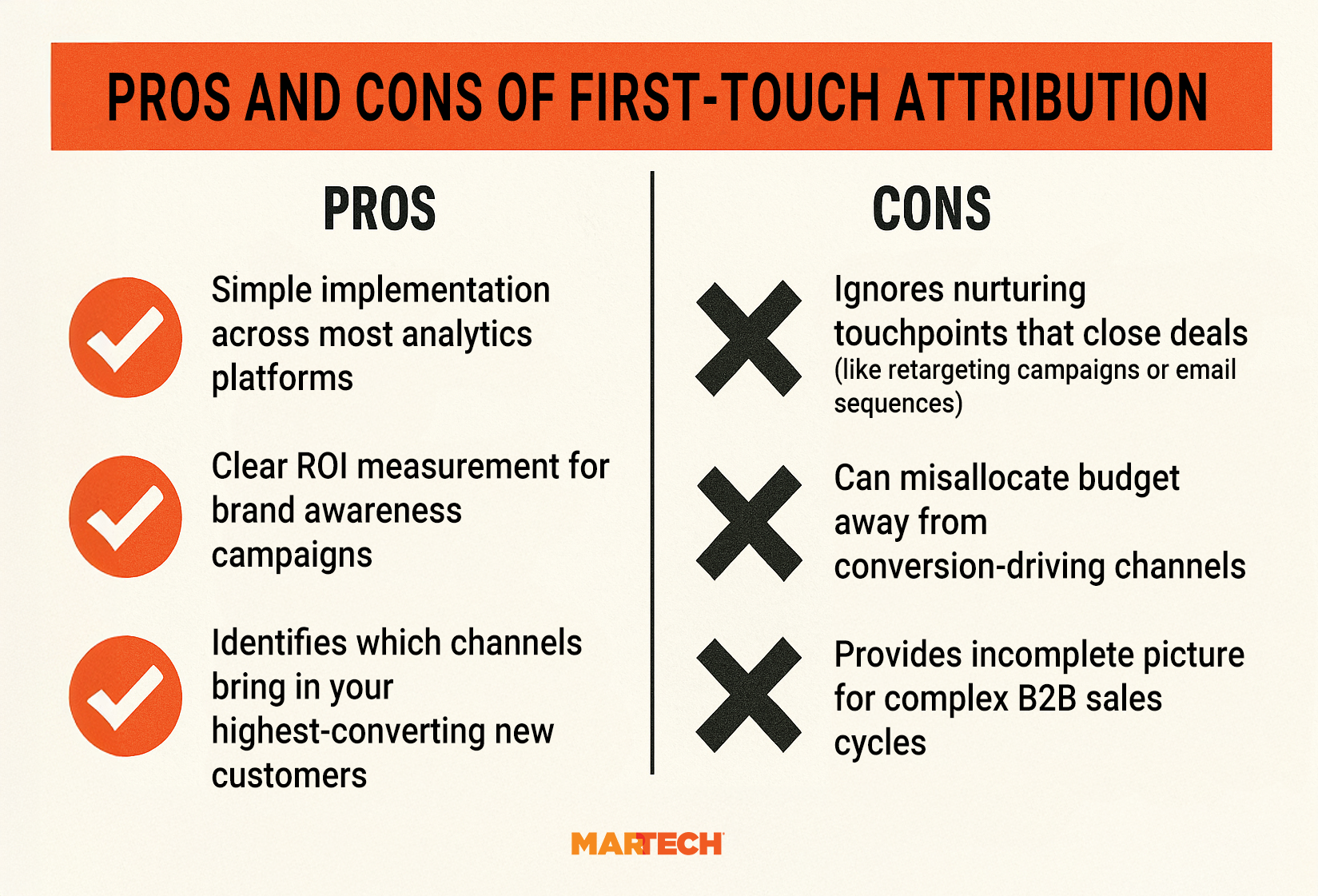
Last-touch attribution
Last-touch attribution gives 100% of the credit to the last marketing channel a customer interacts with before converting. This model prioritizes conversion over discovery—making it ideal for understanding which touchpoints actually close deals.
If you were using last-touch attribution, that customer who discovered your SaaS brand through LinkedIn but signed up to a free trial after a Google search a few days later would go down as a sale driven by organic search.
That means this attribution model isn’t a good fit for long sales cycles with multiple touch points. But it does help businesses with simple sales funnels—say, a HR software company selling payroll solutions to small businesses—understand which channels most often close the deal.
The trade-offs you need to know:

Linear attribution
Linear attribution splits conversion credit equally across every marketing channel a customer interacts with. Think of it as giving every player on your marketing team equal recognition for the win.
So, if a customer:
- Finds you through Google search
- Engages with a LinkedIn ad
- Clicks a retargeting banner
- Then converts via email
Linear attribution gives each touchpoint 25% of the conversion credit.
This approach works particularly well for complex B2B sales cycles where multiple touchpoints contribute to the average conversion. If you’re selling enterprise software or professional services with six-month sales cycles, linear attribution prevents you from oversimplifying the customer journey and giving too much credit to the first or last touch point.
The downside? Some touchpoints genuinely matter more than others.
A demo request deserves more credit than a banner ad impression—but linear attribution treats them equally. This can dilute focus from your highest-impact channels and may overvalue touchpoints that don’t drive sales.
The trade-offs you need to know:
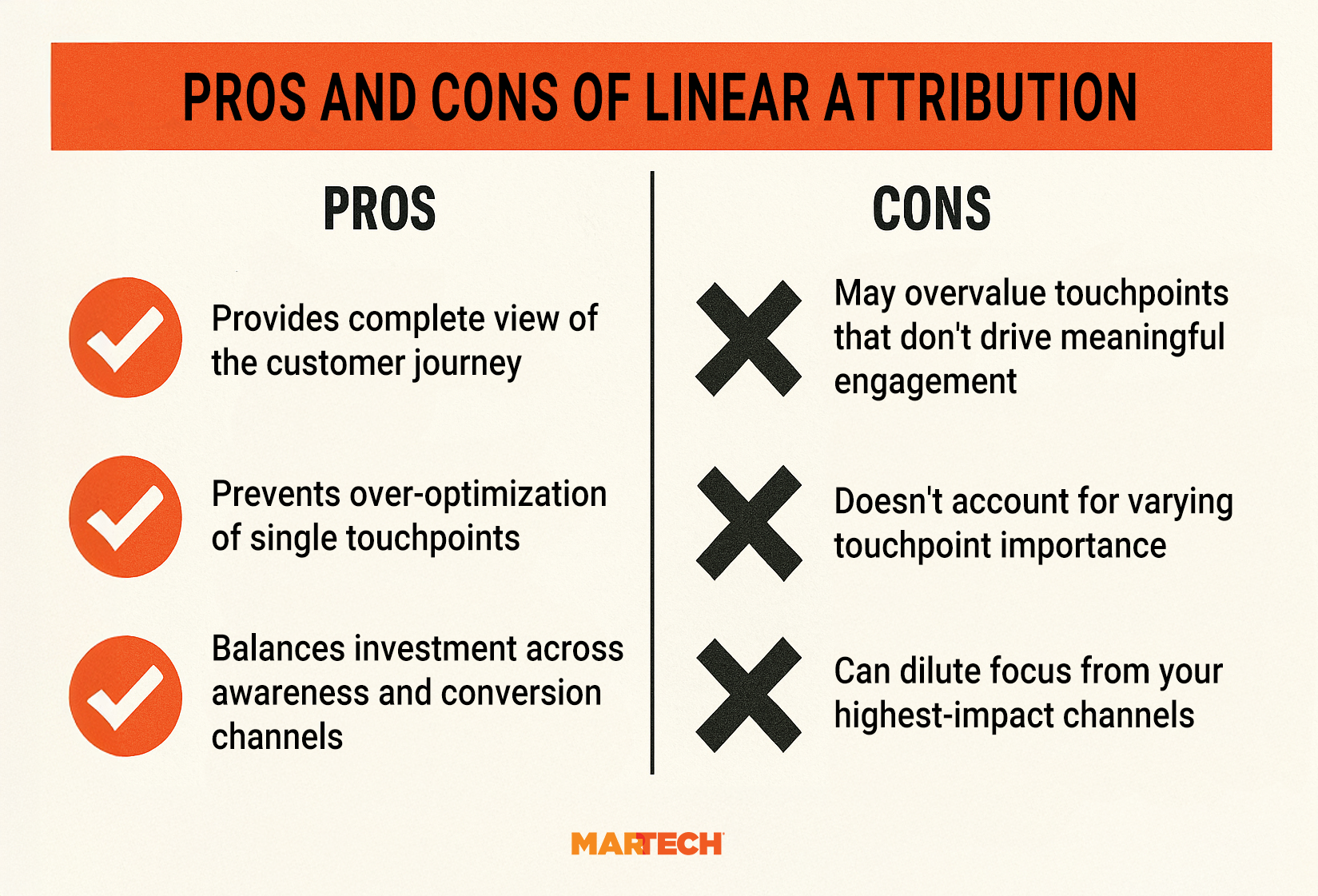
Lead-conversion touch attribution
Lead-conversion touch attribution gives 100% of the credit to the marketing channel that brought a prospect into your sales funnel.
Let’s say a visitor discovers your business through organic search. A few days later, they download a whitepaper after clicking a LinkedIn ad (becoming a lead). Then, they convert weeks later after receiving an email in your nurture sequence.
LinkedIn would get full credit for the sale under this model, since that’s the channel that generated the lead.
Lead-conversion touch attribution works best for businesses with clear lead generation funnels, such as:
- B2B SaaS companies with freemium or trial conversion models
- Professional services firms that convert leads through consultations
- Financial services firms generating leads through downloadable guides or calculators
Pro tip: Use lead-conversion attribution to optimize your lead magnets and gated content. Focus budget on channels that generate leads most likely to become customers.
The trade-offs you need to know:

Time-decay attribution
Time-decay attribution operates on a simple premise: recent touchpoints matter more than old ones. With this model, channels closer to the conversion date receive a bigger percentage of the credit.
Let’s say a customer discovered your solution through organic search 30 days ago, clicked a Facebook ad 10 days ago, then converted via retargeting yesterday. With time-decay attribution, retargeting might get 50% credit for the conversion, Facebook 30%, and organic search 20%.
This model more accurately reflects how customers make decisions. After all, if the customer never saw that last remarketing ad, would they have converted? Their first visit to your site helped put your brand on their radar, but that last ad deserves most credit for driving that particular sale, since it might never have happened without it.
Time-decay attribution is useful because it helps you identify which channels are most effective in driving conversions.
But there’s a catch. It might lead you to undervalue the brand awareness efforts that start customer journeys. Without those articles or social posts that establish your brand, would your retargeting ad have closed the deal?
The trade-offs you need to know:
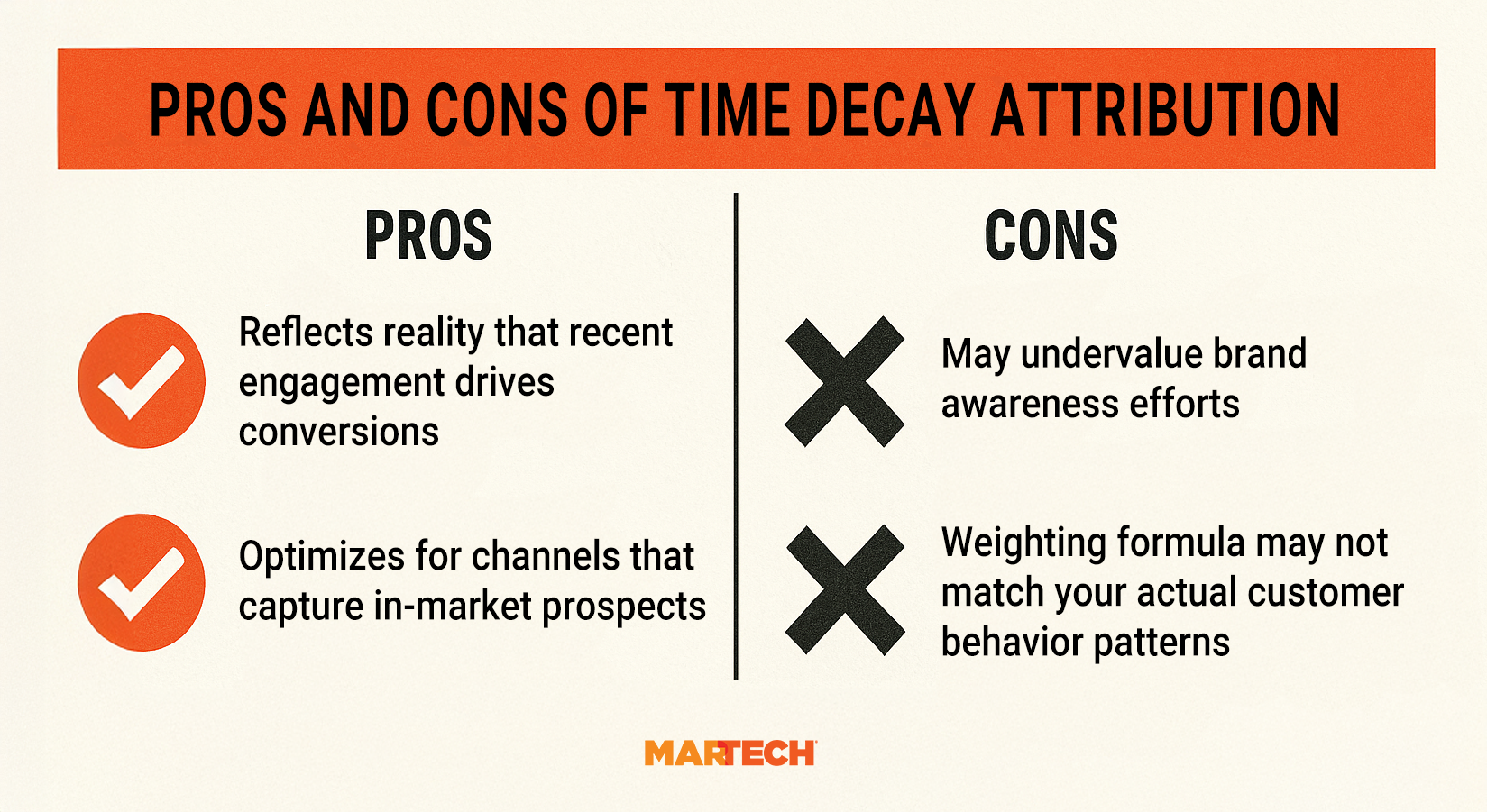
Position-based attribution
Position-based attribution (also called U-shaped attribution) gives 40% credit each to the first and last marketing touchpoints, with the remaining 20% split among middle interactions.
Pro tip: While this 40-40-20 distribution is common, you can adjust the percentages to better reflect your specific customer journey and business objectives.
Instead of potentially giving too much credit to the first or last touch point in the customer journey, this model helps you understand which channels are both building brand awareness and closing sales.
However, a fixed weight might not match your actual customer behavior. Some businesses have crucial mid-funnel touchpoints—like product demos or consultation calls—that deserve more than a small share of the remaining 20% credit.
The trade-offs you need to know:
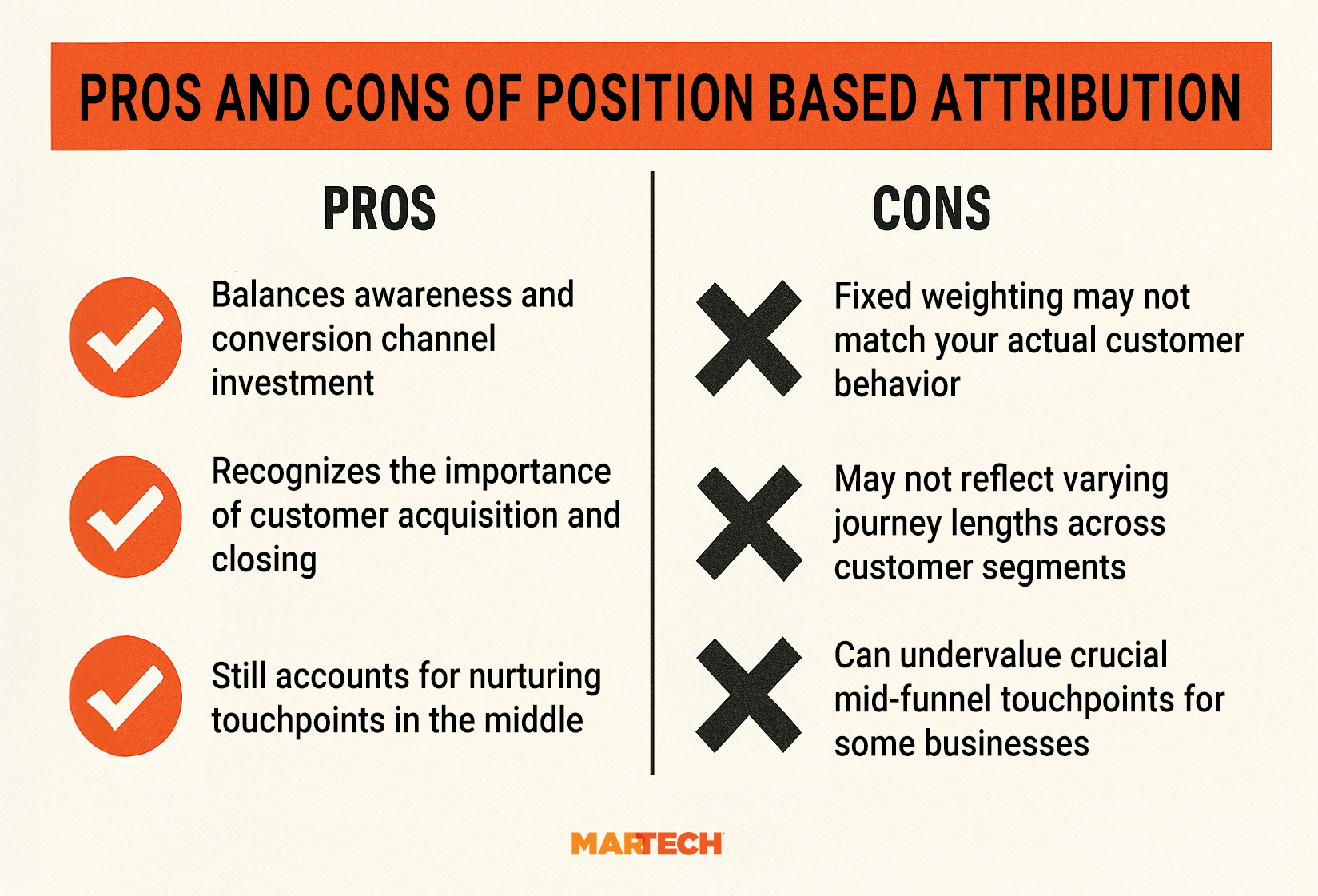
W-shaped attribution
W-shaped attribution gives the most weight to three critical moments: the first touch, the touchpoint that creates the lead, and the last touchpoint before conversion. It gives each of those milestones 30% of the credit for a sale. Then, it splits the remaining 10% with any other touchpoints in the customer journey.
So let’s say a buyer:
- First engages with your LinkedIn thought leadership content
- Lands back on your site after engaging with a retargeting display ad
- Converts to a lead through your product demo
- Is closed through on call with the sales team
W-shaped attribution gives 30% credit each to LinkedIn, the demo, and the sales negotiation. Then the retargeting ad receives the remaining 10%.
This model works best for businesses where lead generation and sales qualification are distinct, measurable events. Like enterprise software companies with long sales cycles and formal lead qualification processes.
But for it to work, you need a clear idea of which assets actually drive qualified leads. Think product demos, free trials, and whitepapers.
The trade-offs you need to know:
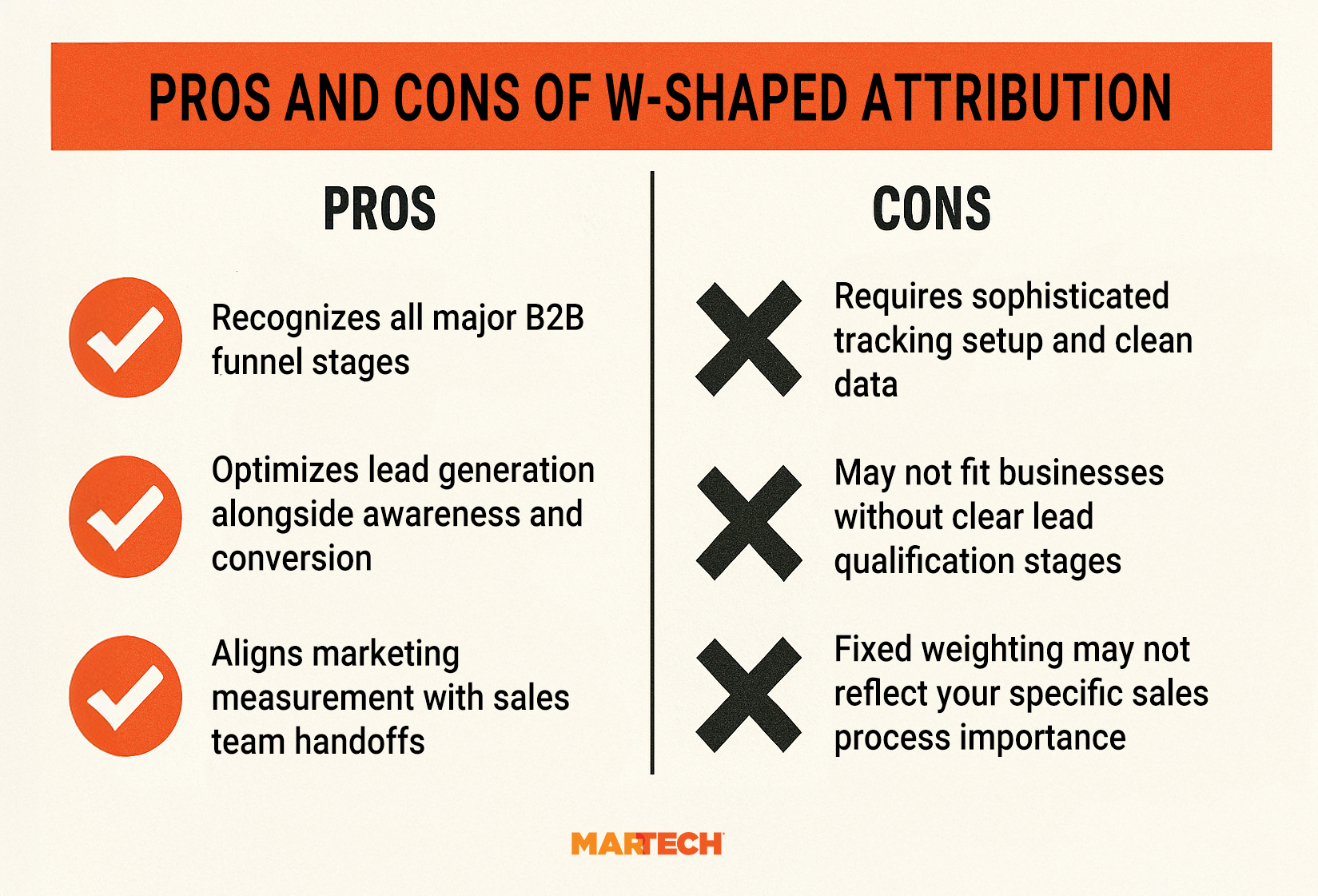
Full path attribution
Full path attribution analyzes every customer touchpoint and assigns credit based on each interaction’s actual influence on the conversion. It’s the most accurate attribution model, giving you a clear picture of which channels are most effective at each stage of the funnel.
But it requires data to work—and lots of it. You’ll need to track thousands of conversions to get a clear picture of how you should weigh each touchpoint in the customer journey.
That makes full path attribution a great fit for large ecommerce companies with thousands of monthly conversions and enterprise SaaS platforms with complex customer journeys. But organizations with less conversion data to work with are better off using a simpler attribution model.
The trade-offs you need to know:
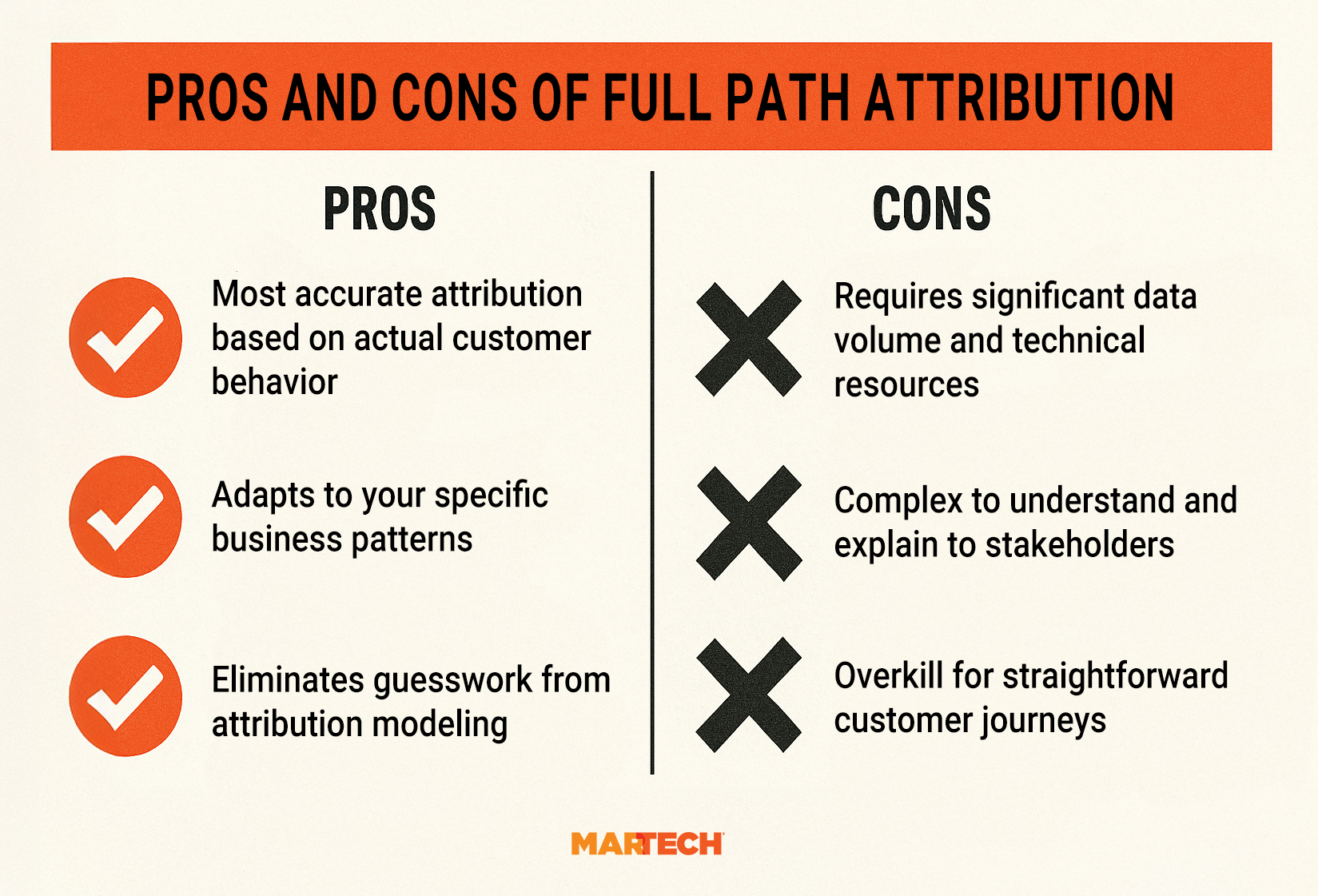
Custom attribution
With custom attribution, you create rules based on your specific business model, customer behavior, and strategic priorities.
Let’s say you’re marketing a freemium SaaS tool, and the majority of conversions come from users hitting the daily usage limit of your free plan. You might assign that touchpoint much more credit for conversions than interactions with your onboarding email sequence, since you know it’s your main driver of sales.
The risk with this model is basing your weightings on assumptions rather than data.
Avoid this by starting with position-based or time-decay attribution. Then, customize attribution based on six months of performance data. You should also use your sales team insights to weight touchpoints that correlate with closed deals.
The trade-offs you need to know:
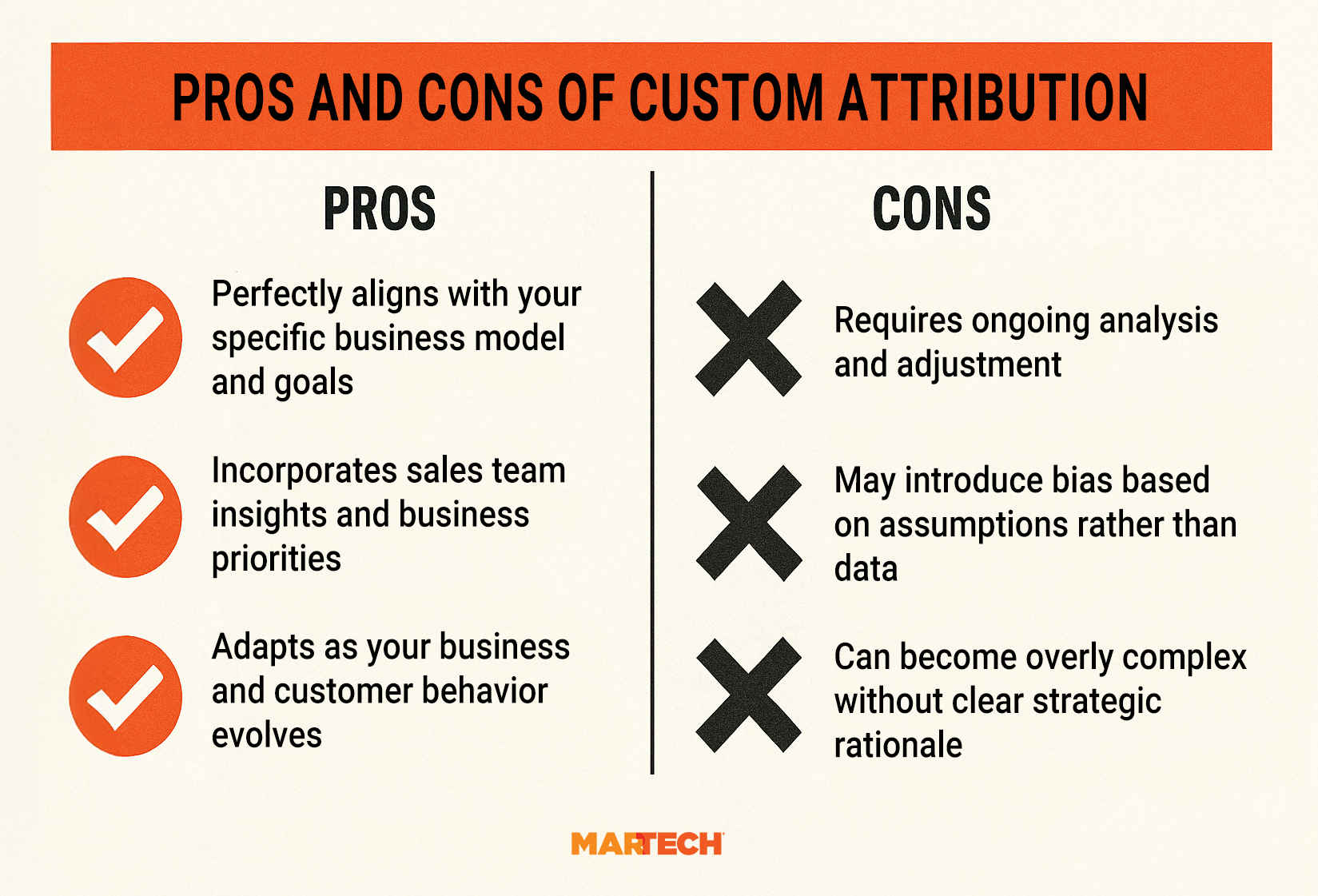
In a perfect multi-touch attribution world, marketers can weigh the impact of each touchpoint based on how it influences the final sale or conversion. This is where martech tools can help.
What Happens When Buyers Ask AI About Your Brand?
✓ Monitor what AI says about your brand 24/7
✓ Get alerts when sentiment drops or info is outdated
✓ Ensure consistent messaging across all AI platforms
Real-time AI monitoring.
Why should marketers care about attribution?
The only way marketers can optimize current and future campaigns is by knowing which touchpoints are effective in driving results.
Without this data, you could end up wasting marketing dollars. In fact, companies waste 40-60% of their digital marketing budgets on ineffective spending, poor targeting, and inefficient strategies, according to research by Proxima.
Marketing attribution aims to redirect the flow of wasted dollars from ineffective channels to the most effective channels and tactics.
As a marketer, you should care about proper attribution because:
- It tells you what touchpoints you should be paying attention to and which have less value
- It helps you predict what’s coming so you can make real-time adjustments in your marketing approach
- It helps you spend your marketing dollars wisely
- It empowers your marketing and sales teams to make better decisions about their budgets and time
- It requires that marketing, sales, product, and management teams talk to each other to evaluate the customer journey holistically
- It banishes data silos
However, marketing attribution isn’t a perfect science.
Marketing strategist Kathleen Schaub refers to markets as “complex adaptive systems,” meaning the interactions between audiences and brands can be unpredictable with so many factors creating feedback loops.
Marketers must acknowledge that ROI measurement is complex. It requires a combination of optimized management structures and high-quality marketing attribution tools.
Who uses or works with marketing attribution tools?
While every team in an organization benefits when they understand their company’s unique buying cycle, marketing attribution tools are generally the purview of marketing teams.
Here are some use cases that highlight these tools and how they’re used.
The CMO of a B2B company wants to understand how the latest top-of-funnel brand strategy is impacting revenue.
Connecting branding initiatives to revenue requires measuring things like brand experience and level of awareness based on interaction and engagement—ultimately tying both to sales. You can integrate tools like SproutSocial and Brandwatch with marketing analytics platforms to understand how marketing impacts brand awareness, which impacts sales.
The CMO of a global retail chain wants to understand what paid media channels contribute to the highest-value customers.
Multi-touch attribution can help this CMO understand which paid media sources deliver the highest value customers by tying the top-of-funnel tactic (e.g., search ads) to mid- and low-funnel activities (e.g., adding items to the shopping cart or initiating a chat on the ecommerce website). The goal here is to redistribute ad spend to the most effective activities without increasing the marketing budget.
The owner of a local restaurant wants to know what offers and promotions resonate best with customers.
Consumer behavior data procurement is vital when making marketing decisions. Marketers need attribution tools to help identify which events in the buyer journey drive the most conversions. Attributing conversion values to specific offers, promotions, and other calls to action can show businesses which circumstances lead to higher levels of customer buy-in.
The CEO of a Fortune 500 tech company wants to move away from third-party data and better understand the buying journey from their customers’ perspective.
Appropriate attribution requires high-quality data. But most marketers currently use third-party cookies to create, track, and optimize ad campaigns. As we move to a cookieless world, marketing attribution will increasingly rely on first-party data using tools like customer data platforms (CDPs) and identity resolution platforms to get a deep understanding of their customers’ buying journey.
The CMO of a CPG brand wants to understand if pairing certain online and offline touchpoints lift brand and/or ad recall.
Marketing attribution, if done right, enables you to unify every channel and touchpoint across the buying journey. AI and machine learning can make these connections for you. These tools can synthesize data from a range of sources to surface insights that can help you understand how offline touchpoints like TV and radio work with digital channels to improve campaign performance.
What types of tools or software enable marketing attribution?
Any tool that helps identify how your ads, content, and media contribute to campaign performance falls under the umbrella of marketing attribution software. But to be considered a true marketing attribution platform, a tool must contain the following features:
- It supports a broad range of online and offline channels: digital, TV, radio, OTT, podcast, and IoT to capture interactions between your customers and your brand
- It offers “big picture” analysis by ingesting—and normalizing—data from a variety of campaigns, platforms, and sources
- It supports statistical modeling to get more meaningful information from incomplete or imperfect data
- It employs predictive analytics generally via AI and machine learning to help marketers plan campaigns
- It uses a variety of different attribution models, including single-touch, multi-touch, algorithmic, and custom models, to support all business types
- It has robust reporting and data visualization features that can deliver insights and reports in real-time based on user-specific KPIs and goals
- It integrates with martech and adtech tools, fitting seamlessly with your tech stack
- It typically has a relationship with walled-garden platforms like Amazon and Facebook to add additional data points that yield deeper insights
Examples of marketing attribution tool capabilities
Marketers looking for tools that give them more in-depth customer touchpoint data will find a slew of helpful functions in attribution tools. Here are some of their capabilities and offerings.
Ingestion and management of offline marketing data. Although more and more marketing touchpoints are moving to digital channels, offline events still account for a large portion of some customer journeys. Attribution tools can help marketing account for this offline data to ensure these touchpoints don’t get lost in the mix.
A single source of truth when evaluating channel effectiveness. Since marketing attribution tools measure touchpoints from a variety of channels and platforms, they’re able to offer marketers a single source of baseline data. This helps increase their confidence in the numbers.
Increased opportunities for personalization. Attribution tools can give marketers a more accurate picture of their customers’ preferred communication mediums and channels. This valuable data makes it easier for marketers to increase personalization.
Campaign spend analysis. These tools do a great job of offering marketers insights into the channels and touchpoints that have the best ROI. This allows them to better allocate campaign spend to the most profitable areas.
How marketing attribution can help marketers succeed
Marketing attribution technology can help marketers justify budgets and plan more effective strategies without third-party cookies. Unifying customer journey data across touchpoints and channels can help marketing and sales teams deliver more value.
Marketers are beginning to understand what consumers already know—it’s all one buying journey. 79% of digital advertisers are now using retail data to inform their strategies, according to a study by The Trade Desk.
While marketing attribution relies on good data, it also requires knowledge of the current market and a multi-disciplinary approach to analyzing and acting on campaign performance data. Marketers who connect the dots across the entire buying journey are in a much better position to anticipate and respond to changes in the market (and in consumer behavior) than those who don’t.
How to implement marketing attribution
Your marketing attribution needs strong foundations to deliver useful insights.
Follow these steps to make sure your tracking the right data from the right places:
Step 1: Define goals
Before you dive into tools and models, you need to get crystal clear on what you’re measuring.
Your attribution goals should reflect your business goals. So, ask yourself:
- Are you optimizing for lead volume, lead quality, or revenue?
- Do you need to track pipeline velocity or customer lifetime value?
- Are you measuring retention and expansion revenue?
Say you’re a B2B SaaS company with a six-month sales cycle. Tracking last-click conversions won’t tell you which channels are actually driving qualified pipeline. A linear attribution model would give you a clearer picture of where sales are coming from.
Define your primary KPI first. Then, build your attribution system around it. This way you’ll end up with data you can act on.
Step 2: Map the customer journey
The more touchpoints you track, the more accurate your attribution model will be.
So, map out your complete customer journey across digital touchpoints like:
- Paid search and social ads
- Organic search and SEO content
- Email campaigns and automation
- Website visits and content downloads
- Webinars and virtual events
And offline touchpoints, such as:
- Trade shows and conferences
- Sales calls and demos
- Referral conversations
- PR and media mentions
Document each touchpoint with its data source and tracking method.
For example, track Google Ads conversions through Google Analytics and UTM parameters. Monitor webinar attendance through a marketing automation platform like HubSpot or Marketo. Track sales calls in your customer relationship management tool (CRM) with lead source fields or measure PR mentions through social listening tools like Brandwatch.
As long as you measure touchpoints, you can attribute value to them.
There’s no such thing as perfect marketing attribution. Don’t let that prevent you from making better decisions with good-enough data.
Pro tip: Add “How did you hear about us?” to your forms to get a better picture of attribution gaps where digital tracking falls short—especially for word-of-mouth referrals and offline touchpoints that don’t show up in your analytics.
Step 3: Choose your attribution model(s)
The right attribution model gives you actionable insights you can use to optimize your marketing campaigns and assets. The wrong one can oversimplify the customer journey—or bog you down in irrelevant data.
The best fit for your business depends on:
- The complexity of your sales funnel
- The length of your typical sales cycle
- The quantity—and quality—of data at your disposal
In general:
- Last-touch or first-touch are the best fits for small businesses with simple sales cycles
- Lead-conversion touch or W-shaped work well for B2B sales with a clear lead funnel
- Time-decay or position-based are a good fit for ecommerce stores with repeat customers
- Linear, W-shaped, or full path is the right move for enterprises with complex sales
- Full path or custom is the best fit for large organizations that handle thousands of monthly sales
Pro tip: Start with a simple model that matches your primary goal, then add complexity as you gather more data.
Step 4: Select the right tools
Your attribution tools should integrate with your existing tech stack and provide you with actionable insights—not just dashboards that look good in a slide deck.
With the right setup, Google’s free tools—Google Analytics 4 (GA4) and Google Ads—can take businesses with simple funnels and limited touchpoints a long way.
GA4 can handle multi-channel attribution by tracking how customers move between organic search, paid ads, email, and social media before converting. It can also switch between different attribution models—like first-click, linear, or time-decay—so you can see how channel performance changes based on how you measure success.
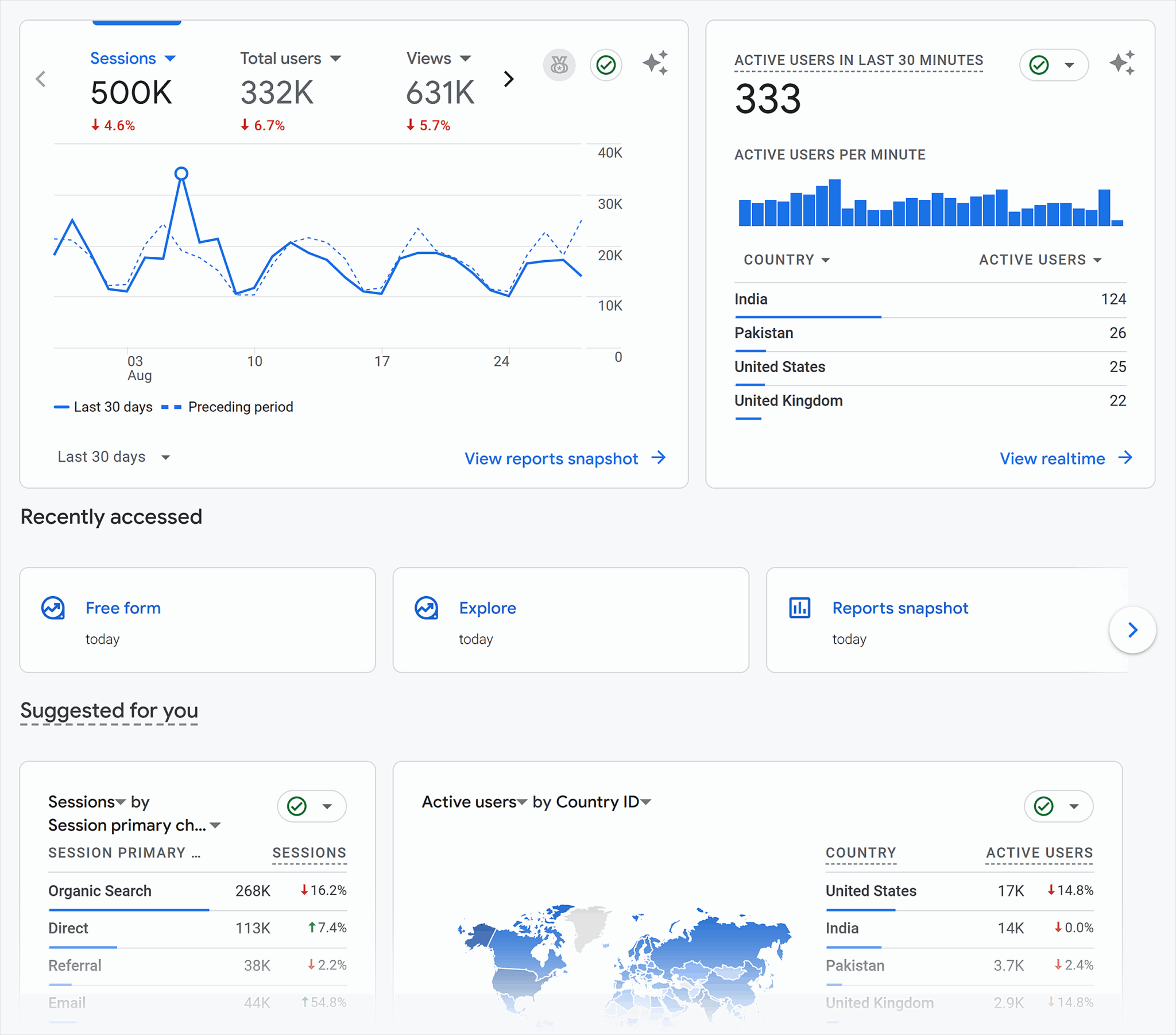
Google Ads has all the data you need to measure the performance of your per-per click advertising (PPC). The platform tracks which keywords, ad copy, and landing pages drive conversions—then automatically adjusts bids based on performance data.
It shows you exactly how much revenue each campaign generates. This way, you can compare cost per acquisition (CPA) across different audience segments, giving you clear ROI metrics for every dollar you spend on search and display advertising.
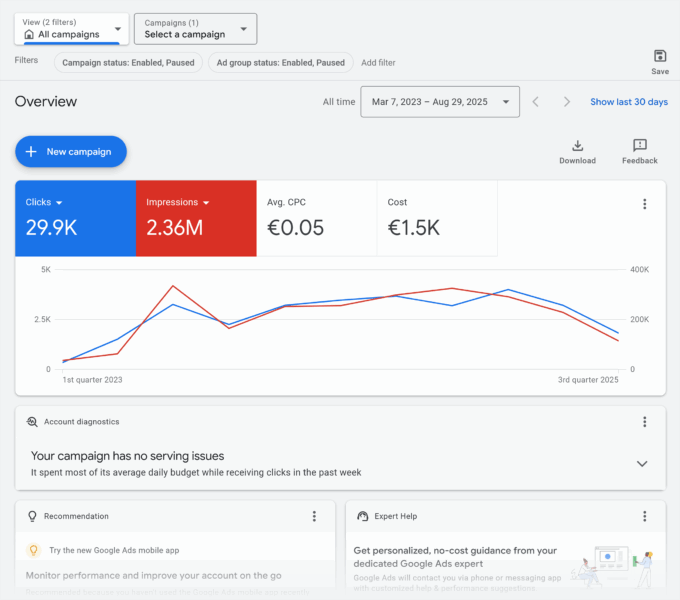
But mid-market companies selling to buying committees with longer sales cycles should look for something a bit more robust. Popular marketing attribution platforms include:
HubSpot’s Marketing Analytics
Are your marketing and sales teams already using HubSpot? Its marketing analytics automatically tracks the full customer journey from first touch to closed deal. It measures email engagement, website behavior, social media interactions—and connects them directly to sales pipeline data and revenue outcomes.
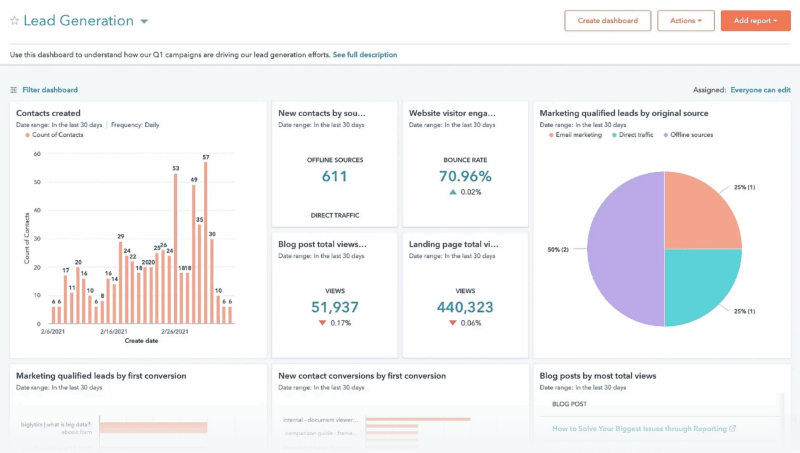
Salesforce Pardot
Pardot is Salesforce’s attribution platform. It connects marketing touchpoints to sales pipeline, tracking the role each channel plays in the customer journey. The platform tracks email campaigns, web forms, content downloads, and social media engagement. Then, it ties each activity to opportunity creation and deal progression in your pipeline.

Ruler Analytics
This dedicated attribution platform integrates the web analytics and CRM platform you’re already using. Ruler tracks phone calls, form submissions, live chat conversations, and offline conversions. Then, it connects this data to your existing analytics and CRM systems to show complete customer journeys.

Dreamdata
This standalone attribution tool was built specifically for B2B companies with complex sales processes. It focuses on account-level attribution to show which channels influence entire buying committees, not just individual contacts.
Dreamdata measures website visits, content engagement, email interactions, and demo requests across all contacts within target accounts—which provides a unified view of how marketing influences entire organizations.

Enterprise companies trying to make sense of massive volumes of data collected across dozens of tools need an enterprise-level attribution platform.
Adobe Analytics
Adobe’s enterprise platform handles millions of touchpoints and can attribute across online and offline channels at scale. Plus, it uses machine learning to create custom attribution models based on your specific customer journey patterns. It tracks everything from TV and radio campaigns to digital ads, email, social media, and in-store purchases for unified measurement across all marketing channels.

Improvado
This standalone tool can connect data from over 500 sources. This makes it perfect for enterprises juggling dozens of marketing tools that need to work together seamlessly. Improvado pulls data from advertising platforms, social networks, email tools, CRMs, and offline sources for comprehensive attribution analysis.
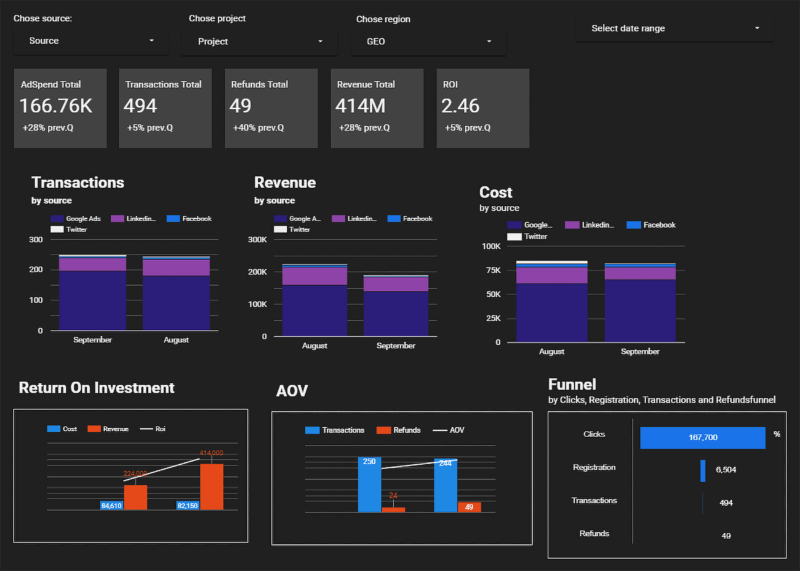
Step 5: Integrate and clean your data
If you want to glean meaningful insights from your attribution model, you need to feed it clean and consistent data.
That starts with standardizing your UTM parameters. Create a naming convention and use it across campaigns and channels.
Use consistent formatting for:
- Campaign names: {year}_{quarter}_{channel}_{campaign_type}
- Source names: google_ads, facebook, linkedin (no variations)
- Medium names: cpc, social, email, webinar
You also need to connect your data sources, including your:
- Web analytics platform
- Google Ads
- Social ads platforms
- CRM
- Marketing automation platforms (like your email marketing software)
Then, consolidate all that data in one place—for example, in a Looker Studio dashboard or an attribution platform like Adobe Analytics.
Once your data is unified, create custom reports that show cross-channel performance and identify attribution patterns. In Looker Studio, you might build dashboards that compare channel performance across different attribution models. This way, you can see how first-touch versus last-touch attribution changes your budget allocation decisions.
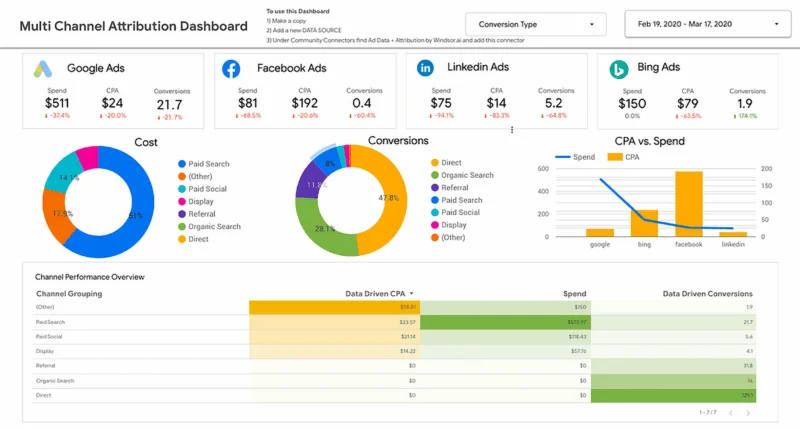
It’s also a good idea to set up automated alerts for unusual attribution patterns, like sudden drops in organic search attribution or spikes in direct traffic that might indicate tracking issues.
Pro tip: Manual data entry introduces human error into the equation. Use a tool like Zapier to automate data flow between platforms.
Step 6: Train teams on reading and applying results
Attribution data only drives ROI when it’s actually used to make decisions.
First and foremost, make sure everyone on your sales and marketing team understands the ins and outs of the attribution model you’ve built. This way they’ll know how to interpret the data.
It’s also important to train your marketing team to:
- Read attribution reports and identify patterns. Look for channels that consistently appear in winning customer journeys, even if they don’t get last-click credit. For example, if LinkedIn ads show up in 60% of your highest-value deals but only get 15% last-click attribution, that suggests LinkedIn is crucial for pipeline quality, not just volume.
- Shift budget toward high-performing touchpoints. Reallocate spend based on true influence, not just direct conversions. If your attribution shows that webinars assist 40% of enterprise deals, increase webinar frequency even if immediate registrations are costly. Track how budget shifts affect pipeline quality over three to six months.
- Optimize campaigns based on assisted conversions. Focus on channels that influence conversions throughout the journey, not just final clicks. If content marketing shows high assist rates but low direct conversions, create more middle-of-funnel content that nurtures prospects toward purchase decisions rather than optimizing for immediate downloads.
- Test new channel combinations based on attribution insights. Use attribution data to identify successful channel sequences, then replicate them. If prospects who see both LinkedIn ads and attend webinars convert 40% more often, create integrated campaigns that drive LinkedIn traffic specifically to webinar registrations rather than running channels in isolation.
And encourage your sales team to:
- Investigate which marketing touchpoints generate the best leads. Have sales reps track which channels produce leads that actually show up to demos, ask qualified questions, and have purchasing authority. If webinar leads consistently have higher show rates and faster deal progression, that should drive your content strategy.
- Provide feedback on lead quality by channel. Create a simple scoring system where sales scores leads on budget, authority, need, and timeline. Google Ads leads might score high on urgency but low on budget, while LinkedIn leads show the opposite pattern. Marketing can then adjust targeting and messaging to improve overall lead quality based on these insights.
- Share prospecting insights that attribution can’t capture. When prospects mention they “saw you everywhere” or reference a competitor comparison that triggered their search, these conversational insights reveal the true influence of brand awareness campaigns. Attribution data often misses this context entirely—but it’s crucial for understanding which touchpoints actually drive purchase decisions.
Pro tip: Train your sales team to identify “phantom pipeline”—leads that look good on paper, but consistently stall in the sales process. For example, leads from webinars might show high attribution scores but consistently stall at the demo stage because prospects attended for educational content.
Make attribution insights part of your monthly planning process—not just a reporting exercise. Create regular attribution review meetings where marketing and sales discuss what the data reveals and how to act on it.
Advanced strategies for attribution maturity
Working with thousands of touchpoints across dozens of channels? These advanced attribution strategies can help your team turn all that data into actionable insights.
Combining attribution with incrementality testing
Incrementality testing is a way of measuring the impact of a specific marketing campaign. It involves comparing a test group exposed to the campaign with a control group that hasn’t seen it. This reveals which of your efforts are actually driving conversions.
Let’s say your attribution models show that LinkedIn ads drive 40% of conversions. But incrementality testing might reveal that those ads only generate 15% incremental lift—meaning most customers would have converted through other channels anyway. This gap between attribution credit and actual incremental impact signals that your attribution model is overcrediting LinkedIn’s influence.
Use incrementality data to recalibrate your attribution weights. If branded search shows high attribution scores but low incremental lift, reduce its attribution weight in your custom model. Conversely, channels with modest attribution but strong incrementality would deserve more credit.
Start testing your highest-spend channels first. The $50K monthly branded search budget that shows high attribution but minimal incremental lift tells you to shift those attribution weights toward channels that actually drive new conversions.
Most incrementality testing requires specialized platforms that can create statistically valid test and control groups. Facebook’s conversion lift tool automatically splits your audience into exposed and control groups, and then measures the conversion difference between them. Google Ads offers similar functionality through brand lift studies for awareness campaigns and conversion lift for performance campaigns.
For cross-channel testing, platforms like Measured, Northbeam, and TripleWhale can run incrementality experiments across multiple ad platforms simultaneously. These tools use geographic holdouts—pausing campaigns in randomly selected regions—to measure true incremental impact.
Using weighted models for different campaigns
Your brand awareness campaigns are going to need a different attribution model than your bottom-of-funnel conversion campaigns. So, create campaign-specific attribution weights based on funnel stage and intent.
With your, top-of-funnel campaigns, consider:
- Weighting first-touch attribution more heavily (60-70%)
- Measuring influence on pipeline creation, not just immediate conversions
- Tracking longer attribution windows (six to12 months for B2B)
For middle-of-funnel campaigns:
- Apply linear or position-based models
- Track progression through funnel stages
- Measure engagement quality alongside conversion volume
And for your bottom-of-funnel campaigns:
- Use last-touch or time-decay models with shorter windows
- Focus on conversions
- Measure conversion rate optimization (CRO) and CPA
Introducing cross-brand attribution for multi-brand enterprises
Multi-brand organizations face a unique attribution challenge. Customers often engage with multiple brands before converting—but traditional attribution tools silo each brand’s performance separately.
Unified customer identity resolution connects all the different ways customers interact with your brands into a single profile. When someone visits Brand A’s website on their laptop, opens Brand B’s email on their phone, then purchases from Brand C in-store, identity resolution links all three touchpoints to the same person.
The process works by matching identifiers across touchpoints: email addresses, phone numbers, device IDs, and CRM records. Advanced systems use probabilistic matching to connect anonymous sessions—like when someone browses without logging in—to known customer profiles based on behavioral patterns and device fingerprinting.
Tools like Segment, Salesforce CDP, and Adobe Real-Time CDP specialize in identity resolution across brands. These platforms ingest data from all your marketing tools, websites, and CRMs, then use machine learning to identify when different data points belong to the same customer.
Implement unified customer identity resolution to track cross-brand journeys:
- Measure portfolio-level attribution alongside individual brand performance
- Create master customer profiles that connect email addresses, device IDs, and CRM records across brands
- Track brand-to-brand referral patterns to understand which brands drive awareness for others
Then set marketing budgets at the portfolio level. If Brand A’s content marketing drives 30% of Brand B’s conversions, Brand B should contribute to Brand A’s content budget.
Pro tip: Use CDPs to create unified customer profiles across brands. This enables true cross-brand attribution without privacy violations.
Connecting attribution data to marketing mix modeling
Attribution excels at tracking digital customer journeys. But it misses the macro factors that move the needle. Seasonality, competitor activity, economic conditions, and offline channels like events or PR can all affect these journeys.
Marketing mix modeling (MMM) fills these blind spots by analyzing aggregated sales data alongside marketing variables over time. This reveals the true ROI of every channel and tactic—helping you get more value from your efforts.
Use attribution for tactical optimization:
- Which ad creative performs better?
- Should you increase spend on Google Ads or Facebook?
- Which landing page variations drive the highest-quality leads?
- Are video ads or static images generating better conversion rates?
Use MMM for strategic planning:
- How much should you invest in brand awareness versus performance marketing?
- What’s the overall ROI of offline channels like conferences, PR, and partnerships?
- How do economic conditions, seasonality, and competitor launches affect your sales?
- Should you prioritize customer acquisition or expansion revenue campaigns?
- What’s the long-term brand equity impact of different marketing investments?
Platforms like Nielsen MMM, Analytic Partners, and Measured specialize in MMM by ingesting sales data alongside marketing spend, external factors like weather and economic indicators, and competitive intelligence.
These tools use regression analysis and machine learning to isolate the impact of each marketing variable on sales performance.
Pro tip: Expect to invest six to 12 months collecting baseline data before MMM becomes reliable. The models need enough historical data to separate correlation from causation across seasonal cycles and market conditions.
Applying predictive budget allocation using AI
Many dedicated attribution platforms now use AI to forecast which channels will perform best under different scenarios and suggest how you can maximize the ROI on your marketing spend.
Machine learning algorithms can:
- Predict channel performance based on historical patterns, seasonality, and market conditions
- Automatically adjust bids and budgets based on real-time attribution insights
- Identify emerging channels before they become saturated and expensive
As with any AI tool, it’s the best practice to implement predictive budget allocation one step at a time. Test automated bid optimization within individual channels before thinking about asking AI to map out a multi-channel budget based on attribution. And make sure a human is giving the green light to every decision along the way.
Privacy, data loss, and the future of attribution
Third-party cookies have powered attribution for decades. But they don’t comply with privacy regulations like the EU’s General Data Protection Regulation (GDPR) act and the California Privacy Rights Act (CPRA). Which means they’re being phased out.
Users now need to opt in to being tracked by web and app cookies. And as you can imagine, the vast majority choose not to. Research by Flurry reveals that just 6% of US users allowed their apps to track them after the launch of Apple’s iOS 14.5—which requires apps to ask permission before tracking users across other platforms.
The result? Attribution windows have collapsed from 28 days to seven days. Retargeting audiences have shrunk. Conversion tracking has become much more of a guessing game.
The truth is, attribution was already broken. You were measuring correlation, not causation. The clean, linear customer journey from first click to final purchase was largely a myth, even before iOS 14.5.
Smart marketers are adapting by building attribution strategies that don’t rely on perfect tracking.
Make these changes to how you approach attribution in a cookieless world:
Implement server-side tracking
Instead of relying on browser cookies, server-side tracking captures conversion data directly from your servers. You can then process, filter, and enrich the data before forwarding it on your analytics platforms.
This helps you overcome the limitations of third-party cookie restrictions—as well as bypass ad blockers that target client-side tracking scripts. Plus, less code running in the user’s browser means your site loads faster.
Just beware that you still have to follow privacy regulations, such as GDPR and CPRA, when you use server-side tracking. So you still won’t be able to use it to track visitors that don’t consent to being tracked. And that means you’re realistically never going to get a complete picture of your web visitors’ behavior.
Model conversions with AI-driven attribution
Google, Facebook, and other platforms use machine learning to model conversions they can’t directly measure. This can help fill the gaps left in your attribution model by the loss of third-party cookies.
Most major ad platforms now offer modeled conversions as a built-in feature. Google’s enhanced conversions feature uses machine learning to estimate conversions when cookie tracking fails. It hashes your first-party customer data (like email addresses) and matches it against Google’s signed-in user base to fill tracking gaps.
Facebook’s conversions API works similarly, using server-side data and machine learning to model conversions that iOS 14.5+ privacy changes made invisible. The platform compares your customer data against Facebook’s user profiles to estimate which ad interactions led to purchases, even when direct tracking isn’t possible.
Enable enhanced conversions in Google Ads by uploading customer lists or integrating your CRM data. Facebook’s conversions API requires more technical setup. You’ll need to send conversion data directly from your servers to Facebook, bypassing browser limitations entirely.
Modeled conversions can be accurate in aggregate. But keep in mind that they’re estimates, not facts. Use them for budget allocation decisions, but don’t rely on them for granular campaign optimization.
Get the most from them by:
- Focusing on conversion volume trends rather than exact numbers
- Cross-referencing modeled data with your actual sales and revenue data
- Testing incrementality to validate that modeled attribution aligns with real business impact
Implement privacy-safe measurement
Data clean rooms (DCRs) are a good option for enterprise businesses looking to fill the hole left in their attribution models now that third-party cookies are being deprecated.
Here’s how they work:
Two or more organizations pool their first-party customer data together in a cloud-based DCR. They can then draw on each other’s data to paint a more detailed picture of the customer journey.
Let’s say Coca-Cola wanted to measure whether its TV ads actually drive in-store sales. They could set up a DCR with Target to find out.
Coke would provide data about which ZIP codes saw their ads, and Target would provide sales data by location. But neither company would see the other’s raw data.
Instead, DCRs run automated queries on the combined datasets without exposing individual records. The system might analyze correlations between Coke’s ad exposure data and Target’s sales spikes. Then, it might return aggregate insights like “stores in markets with 70%+ ad reach saw 15% higher Coke sales compared to unexposed markets.”
The DCR essentially acts as a secure intermediary that performs the analysis and returns only statistical summaries. No customer-level data ever leaves each company’s control.
Advanced DCRs use techniques like differential privacy and secure multi-party computation to ensure individual privacy while still enabling meaningful attribution insights. This would help Coke understand the impact its ads are having without either company compromising their customer data security or competitive advantage.
DCRs can help enterprise organizations get better attribution insights and work with partners without sharing sensitive data. But they’re pricey to set up—and your team will need serious technical chops to make them work properly.
Prepare for imperfect attribution
The marketers who thrive in a world without third-party cookies are the ones who’ve learned to combine a collection of attribution evidence instead of relying on a single source of truth.
The goal is no longer perfect tracking—as if that were ever possible anyway. Now, the goal is to understand which channels drive real business results, even when you can’t trace every click.
Smart CMOs are already adapting. They’re focusing on the data that prove your marketing works: revenue growth, customer lifetime value, and sustainable customer acquisition costs. And they’re building measurement strategies around incrementality testing, media mix modeling, and first-party data collection.
Remember: Attribution’s job isn’t to provide perfect data—it’s to facilitate better decisions. Focus on building attribution systems that make your marketing more effective, even if they’re not 100% accurate.
Resources for learning more about marketing attribution
There are many tools and resources to help brands track and gain insights from each customer touchpoint. Here are a few to review next:
- If you want better outcomes, stop relying on last-touch attribution. Discover why last-touch attribution can cloud what’s really driving conversions.
- How AI and ML bridge the attribution disconnect across marketing channels. Learn how AI can help you connect digital spend to in-store sales for better ROI.
- How attribution masks what’s actually driving growth. Take a deep dive into how to combine incrementality testing and marketing attribution for the best results.
- The end of easy PPC attribution–and what to do next. Learn how to rebuild PPC attribution in a cookieless world so you can see what’s really working.
New on MarTech